Table of Contents
 Historic Courthouses in the U.S.: History, Facts, and Architectural Wonders
Historic Courthouses in the U.S.: History, Facts, and Architectural Wonders
Historic courthouses are distinctive symbols of justice, governance, and architectural ingenuity in the United States. These structures have served as legal battlegrounds for groundbreaking cases, shaping the nation's judicial system while evolving alongside American society. From early colonial courtrooms to modern grand structures, courthouses have evolved in both design and function. Many of them have served as the stage for landmark decisions, civil rights battles, and community gatherings.
Over time, iconic U.S. courthouses have been preserved, restored, or adapted to meet modern standards while maintaining their historical significance. Historic courthouses in the U.S. continue to represent the foundations of American democracy and the lasting principles of the justice system, while also showcasing the craftsmanship and architectural vision of the eras in which they were built.
 A Brief History of Courthouses in the U.S.
A Brief History of Courthouses in the U.S.
Courthouses have played no small role in shaping the history of the legal system in the United States. The historic courthouse of the past was seen as more than just a building where legal cases may be heard, but also as a gathering place for communities and centers of the local government. The tradition of courthouses in the United States dates back to the colonial era when early settlers established judicial buildings to handle disputes, enforce laws, and maintain order.
The oldest courthouse in America was the historic Queen Anne's County Courthouse, built in 1708 in Maryland. This landmark courthouse marked the beginning of a structured legal system in the colonies, providing a space for trials, legal proceedings, and civic engagement. During the colonial era, courthouses in America were modest in design and often modeled after English town halls and local market buildings. Those early courthouses were typically simple, one-story structures containing a single courtroom. Despite their plain appearance, they quickly became important fixtures in community life.
In the years following independence, courthouses became key to the growth of the American legal system. Located in central town squares, they often served multiple purposes, housing courts, public meetings, and community events.
Over time, courthouse design began to evolve. Changes in architecture reflected shifts in society, law, and government. Larger populations, more complex legal systems, and growing concerns about safety led to more secure and formal structures. Nowadays, courthouses feature multiple courtrooms, advanced security measures, and architectural elements reflecting their importance in upholding justice and public order.
 Historic Courthouses in the U.S.
Historic Courthouses in the U.S.
The oldest courthouses in the United States date back to the 18th and 19th centuries. While these buildings served as enduring symbols of America's legal and architectural heritage, their original structures were built for simpler times. Today, many of these courthouses have undergone careful preservation, restoration, and modernization to ensure they continue serving the public while retaining their architectural and historical significance.
The Oldest Courthouses in the U.S.
Here are some old courthouses, some of which have stood the test of time.
Queen Anne's County Courthouse - Maryland

The Queen Anne's County Courthouse, built in 1708, is considered the oldest courthouse in America. Originally constructed when Maryland was still part of Virginia, this courthouse featured a dirt floor and oak wall sheathing, reflecting early colonial architecture. It also included a whipping post and stocks, which were common judicial punishments at the time. Though it is no longer used for court proceedings, the courthouse has been preserved as a museum, offering visitors a glimpse into early American justice.
Chester County Courthouse - Pennsylvania
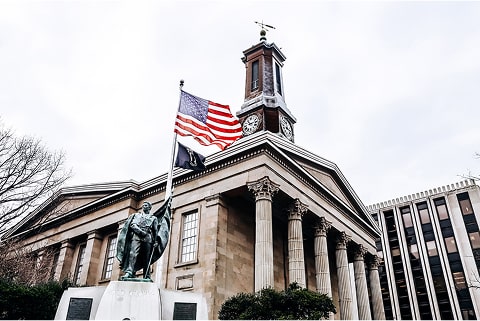
The historic Chester County Courthouse, built in 1724, was originally the county courthouse for Chester County, Pennsylvania. It later became the courthouse for Delaware County until 1851, after which it was repurposed as a town hall. This courthouse holds historical importance as the site of the first public reading of the Declaration of Independence after its announcement in Philadelphia. Today, it remains one of the oldest public buildings in continuous use in the United States, serving various civic functions.
King William County Courthouse - Virginia
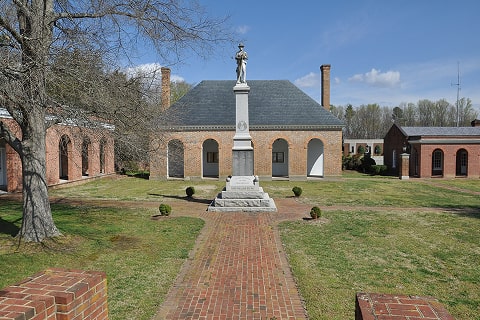
Located in King William in Virginia, the King William County historic courthouse is the oldest courthouse in America and remains in continuous use till today. The courthouse was constructed in 1725 on a spacious 3-acre property and features traditional colonial-style architecture, which reflects the historical legacy of Virginia's colonial era. The design is typical of the time, with a rectangular floor plan, a central entrance, and a hipped roof. The courthouse was built with locally made bricks and has served as the center of county justice for nearly 300 years. Court is still held in the historic structure on a limited basis.
Old Salem County Courthouse - New Jersey
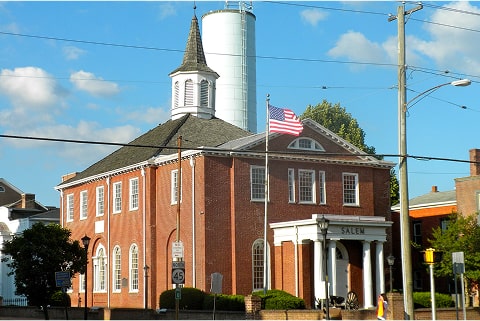
Located in Salem, New Jersey, the Old Salem County Courthouse was built in 1735 and is the second oldest courthouse in continuous use in America. It has a rich history that includes hosting revolutionary war proceedings and is often used for ceremonial functions today. This courthouse played a significant role in colonial history, serving as the site of a petition to King George III in 1774, where local leaders voiced grievances against British rule. It was also the location of the treason trials of 1778, where suspected Loyalists were prosecuted for aiding the British during the Revolutionary War.
As one of the oldest continuously operating courthouses in the country, it reflects early American legal traditions and is recognized for its well-preserved Georgian architecture. The courthouse is designed in a rectangular form and features a central entrance beneath a gable roof with a pediment. Its exterior is constructed of brick and is accented with a decorative entablature that includes dentil molding. Inside, the building houses a spacious courtroom with wood-paneled walls and a high ceiling, along with several smaller rooms used for offices and judicial chambers.
Hanover County Courthouse - Virginia
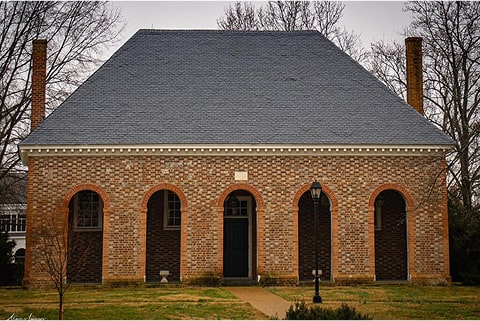
Image by Arniesc1 via Wikimedia Commons, licensed under CC BY-SA 4.0
The Hanover County historic courthouse, located in Hanover County, Virginia, is one of the oldest courthouses still in use in the United States. Built around 1735 (although some records claim the construction occurred between 1937 and 1942), this historic courthouse has played a significant role in American legal history and remains a symbol of colonial-era justice.
The courthouse is best known as the site of the Parson's Cause case, argued by Patrick Henry in 1763. This case was a pivotal moment in colonial resistance against British rule, as Henry challenged the authority of King George III in overturning local legislation. Additionally, the courthouse has witnessed key moments in American history, including events related to the Revolutionary War and the Civil War. Troops from both conflicts passed through the area, and the courthouse remained a central location
Most Architecturally Amazing Courthouses
Courthouses in the United States often serve as more than legal venues; many of them also reflect exceptional creativity, engineering, and regional architectural identity. Some of the prettiest courthouses in the U.S. include the following:
United States Courthouse - Springfield, Massachusetts
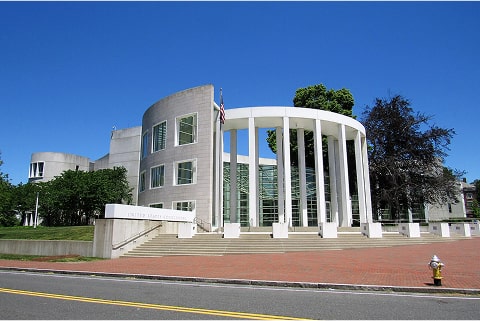
Image by Farragutful via Wikimedia Commons, licensed under CC BY-SA 4.0
Completed in 2008, the U.S. Courthouse in Springfield is a modern architectural achievement blending tradition with innovation. Designed by renowned architect Moshe Safdie, the structure is known for its clean lines, curved glass curtain walls, and thoughtful use of natural light. A key highlight of the building is a 200-foot mural created by internationally acclaimed artist Sol LeWitt, which adds a bold visual element to the interior. The courthouse also offers scenic views of preserved heritage trees surrounding the site, seamlessly blending natural beauty with contemporary architecture. In recognition of its exceptional design and integration of art and environment, the building received a GSA Design Award in 2009 and is considered one of the most beautiful courthouses in the U.S.
Cedar Rapids U.S. Courthouse - Cedar Rapids, Iowa

The Cedar Rapids U.S. Courthouse, completed in 2012, stands as a testament to modern federal architecture and sustainable design. It was designed collaboratively by OPN Architects and William Rawn Associates. The 287,600-square-foot courthouse architecture is situated along the Cedar River in Cedar Rapids, Iowa. The courthouse's architectural features include a prominent curved glass façade that invites natural light into the interior spaces. This not only enhances the courthouse's aesthetic appeal but also aligns with the principles of transparency in the judicial process.
Key eco-friendly features include blast-resistant glazing, solar panels, a rainwater harvesting system, and a green roof, all contributing to the building's reduced environmental footprint. In recognition of its architectural excellence, the courthouse received the U.S. General Services Administration (GSA) Design Award in 2016.
U.S. Federal Courthouse, Jackson, Mississippi
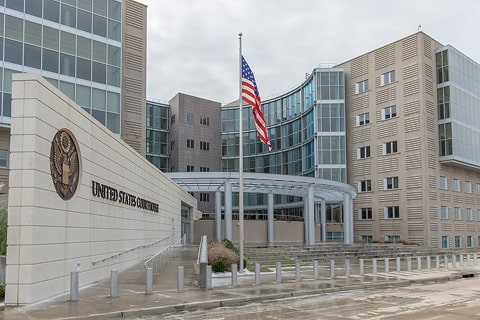
The U.S. Federal Courthouse in Jackson, Mississippi, completed in 2010, exemplifies modern federal architecture that harmonizes functionality with symbolic design. Designed by H3 Hardy Collaboration Architecture under the General Services Administration's (GSA) Design Excellence Program, the courthouse replaces the 1930s-era James O. Eastland U.S. Courthouse, introducing a contemporary aesthetic to Jackson's civic landscape.
Spanning approximately 400,000 square feet, the courthouse comprises two six-story wings connected by an open-air rotunda. This central rotunda not only facilitates natural light penetration but also serves as a communal space, reflecting the transparency and openness of the judicial process.
Architectural elements of the courthouse design draw inspiration from local contexts; the courthouse's alignment with the Mississippi State Capitol's Beaux-Arts profile and its curved enclosures echo the capitol's dome, establishing a dialogue between the old and the new.
Restored Historic Courthouses
Once at risk of deterioration, many historic court buildings in the United States have undergone significant restoration to preserve their architectural beauty and civic function. Restoration efforts on old courthouses often involve significant challenges, such as structural damage, outdated systems, and the need to comply with modern safety codes. The following courthouse buildings in the United States have undergone significant restoration since they were built:
New Haven County Courthouse - New Haven, Connecticut
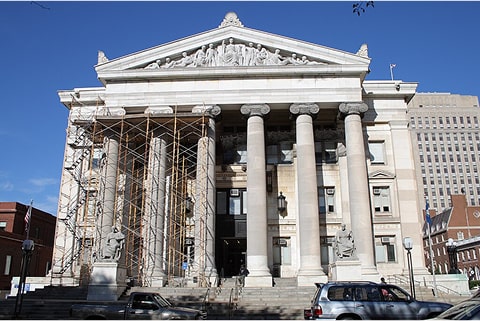
Image by Sage Ross via Wikimedia Commons, licensed under CC BY-SA 3.0
The New Haven County Courthouse, a landmark example of Beaux-Arts architecture, underwent an extensive exterior restoration in the 2010s to preserve its historic beauty. Originally completed in 1914, the courthouse served the city of New Haven for a century, when the State of Connecticut initiated a major rehabilitation project to address significant deterioration.
The courthouse preservation effort, led by JCJ Architecture in partnership with Kronenberger & Sons Restoration, focused on reviving the courthouse's crumbling exterior while allowing judicial operations to continue without interruption. The two-year project included both structural and decorative repairs, with special attention paid to the courthouse's limestone and marble façade.
Artisans replicated and replaced deteriorated marble volutes atop the column capitals, rebuilt the original wooden entry doors, and carefully restored and abated lead from the windows, including stained glass panels. Roofing elements, exterior stairs, and skylights were also repaired to maintain both safety and integrity.
While the exterior restoration was completed successfully, the interior restoration of this iconic courthouse is planned for a future phase.
Luzerne County Courthouse - Wilkes-Barre, Pennsylvania
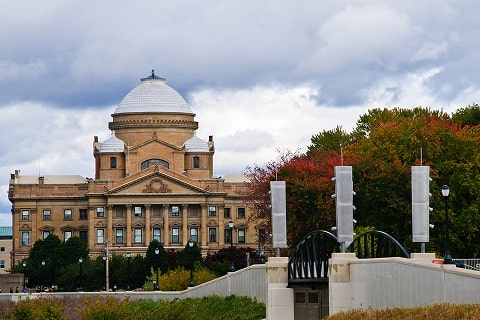
Image by Phanaticvia Wikimedia Commons, licensed under CC BY-SA 2.0
Built in 1906, the Luzerne County Courthouse in Wilkes-Barre, Pennsylvania, is a distinguished example of Classical Revival architecture, featuring a grand dome, plasterwork, and rich decorative finishes. For decades, much of its ornate interior, particularly in the south foyer, had suffered from deterioration and misguided courthouse preservation attempts that altered its original appearance.
In the 2010s, a major interior restoration project was undertaken by the John Canning Company, a nationally recognized firm specializing in historic preservation. Their work focused on the courthouse's 53-foot-diameter domed south foyer, which contains dozens of painted panels depicting U.S. presidents, Pennsylvania state officials, and notable local figures. Many of these elements had been overpainted or inaccurately restored since the 1920s, leading to a loss of the building's original artistic integrity.
Through extensive historic paint analysis and research, the Canning team painstakingly conserved and restored the decorative painting, returning the dome and surrounding surfaces to their intended early 20th-century appearance. In addition to repainting, the restoration addressed the preservation of decorative plaster, architectural gilding, wood finishes, and ornamental bronze detailing throughout the foyer.
Conrad B. Duberstein U.S. Bankruptcy Courthouse - Brooklyn, New York
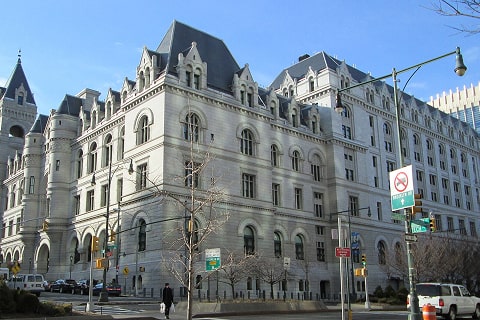
Image by Beyond My Ken via Wikimedia Commons, licensed under CC BY-SA 4.0
Located in downtown Brooklyn, the Conrad B. Duberstein U.S. Bankruptcy Courthouse was originally built in 1891 and is considered an important historic asset in New York City.
In 1999, the U.S. General Services Administration (GSA) acquired the building and launched a significant interior restoration project to modernize its functionality while preserving its architectural heritage. This project involved the restoration of original plasterwork, stone detailing, historic windows and doors, as well as the integration of a new interior atrium with skylights, which brought natural light into the building's central spaces. Additionally, three new courtrooms were added to meet the growing needs of the U.S. Bankruptcy Court for the Eastern District of New York.
Further demonstrating a commitment to preservation, the building underwent an extensive six-year exterior restoration, completed in 2013, led by the Boston-based architecture firm Goody Clancy. This effort focused on restoring 75,000 square feet of granite and terracotta cladding, which included the meticulous replacement of nearly 16,000 individual terracotta pieces.
In 2014, the project received the prestigious Lucy G. Moses Preservation Award from the New York Landmarks Conservancy, often referred to as the "Oscars of preservation" in New York City.
 The Timeless Significance of Historic Courthouses
The Timeless Significance of Historic Courthouses
Historic courthouses are more than just buildings or centers of legal proceedings. They are timeless symbols reflecting the evolution of justice, governance, and civic life over different eras. Across the United States, these structures have witnessed centuries of decisions and transformations, shaping the nation's legal system.
Architecturally, iconic U.S. courthouses reflect the artistry and craftsmanship of different eras, preserving styles ranging from colonial simplicity to grand neoclassical designs. Their meticulous restoration and preservation efforts ensure that they remain functional while honoring their historical significance.
Beyond their architectural beauty, these courthouses continue to serve as many landmark courthouses still operate as judicial centers, maintaining traditions that date back to the founding of the nation. Others have been repurposed as museums, civic spaces, or landmarks, allowing future generations to connect with their rich legacy.
 FAQ about US Historic Courthouses
FAQ about US Historic Courthouses
What is the oldest courthouse in the USA?
The King William County Courthouse in Virginia, built in 1725, is the oldest courthouse in continuous use in America. However, Queen Anne's County Courthouse, built in 1708, is considered the oldest courthouse in America. Although it is no longer used for court proceedings as it has been preserved as a museum.
What is the biggest courthouse in the United States?
The Thomas F. Eagleton United States Courthouse, located in St. Louis, Missouri, is the largest single courthouse in the United States. Completed in 2000, it stands 29 stories tall and covers 987,775 square feet. The courthouse houses the United States District Court for the Eastern District of Missouri and the United States Court of Appeals for the Eighth Circuit.
How many courthouses are there in the U.S.?
There are over 3,100 courthouses across the United States as of April 2025. This number includes state, county, city, and federal courthouses, each serving different judicial functions.
What is the most important court in the United States?
The Supreme Court of the United States is the highest and most important court in the United States. Established in 1789, it has final appellate jurisdiction over all federal and state court cases involving constitutional or federal law.
